Commercial Structure and Legal Regulations - Desklib
VerifiedAdded on 2022/11/01
|12
|2752
|463
AI Summary
This article discusses commercial structure and legal regulations in two different cases. The first case deals with the modification of the constitution of a company and the second case deals with the binding of a loan agreement. The article provides an analysis of the cases and the relevant provisions of the Corporations Act of 2001. The subject matter is relevant to business and law courses.
Contribute Materials
Your contribution can guide someone’s learning journey. Share your
documents today.
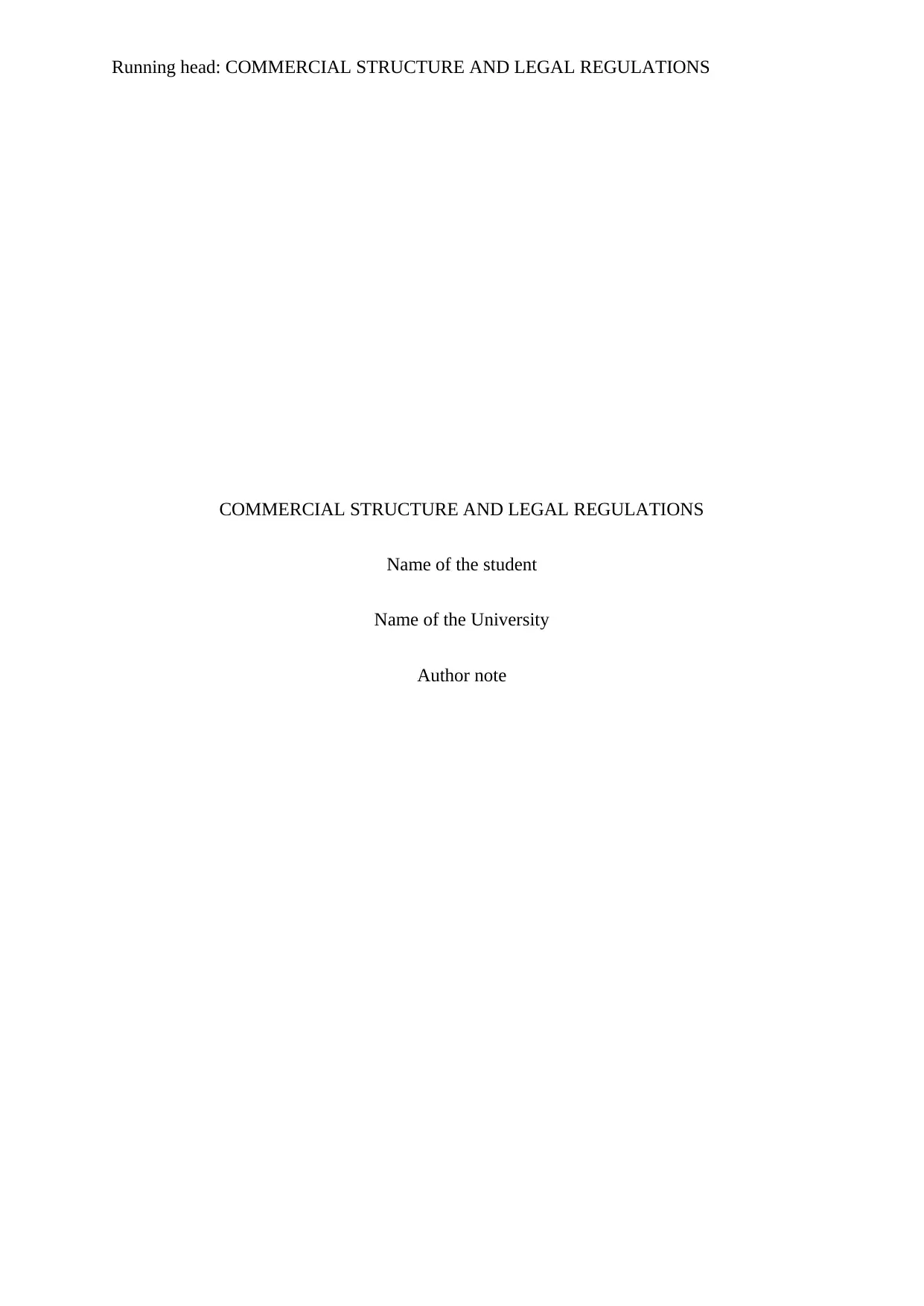
Running head: COMMERCIAL STRUCTURE AND LEGAL REGULATIONS
COMMERCIAL STRUCTURE AND LEGAL REGULATIONS
Name of the student
Name of the University
Author note
COMMERCIAL STRUCTURE AND LEGAL REGULATIONS
Name of the student
Name of the University
Author note
Secure Best Marks with AI Grader
Need help grading? Try our AI Grader for instant feedback on your assignments.
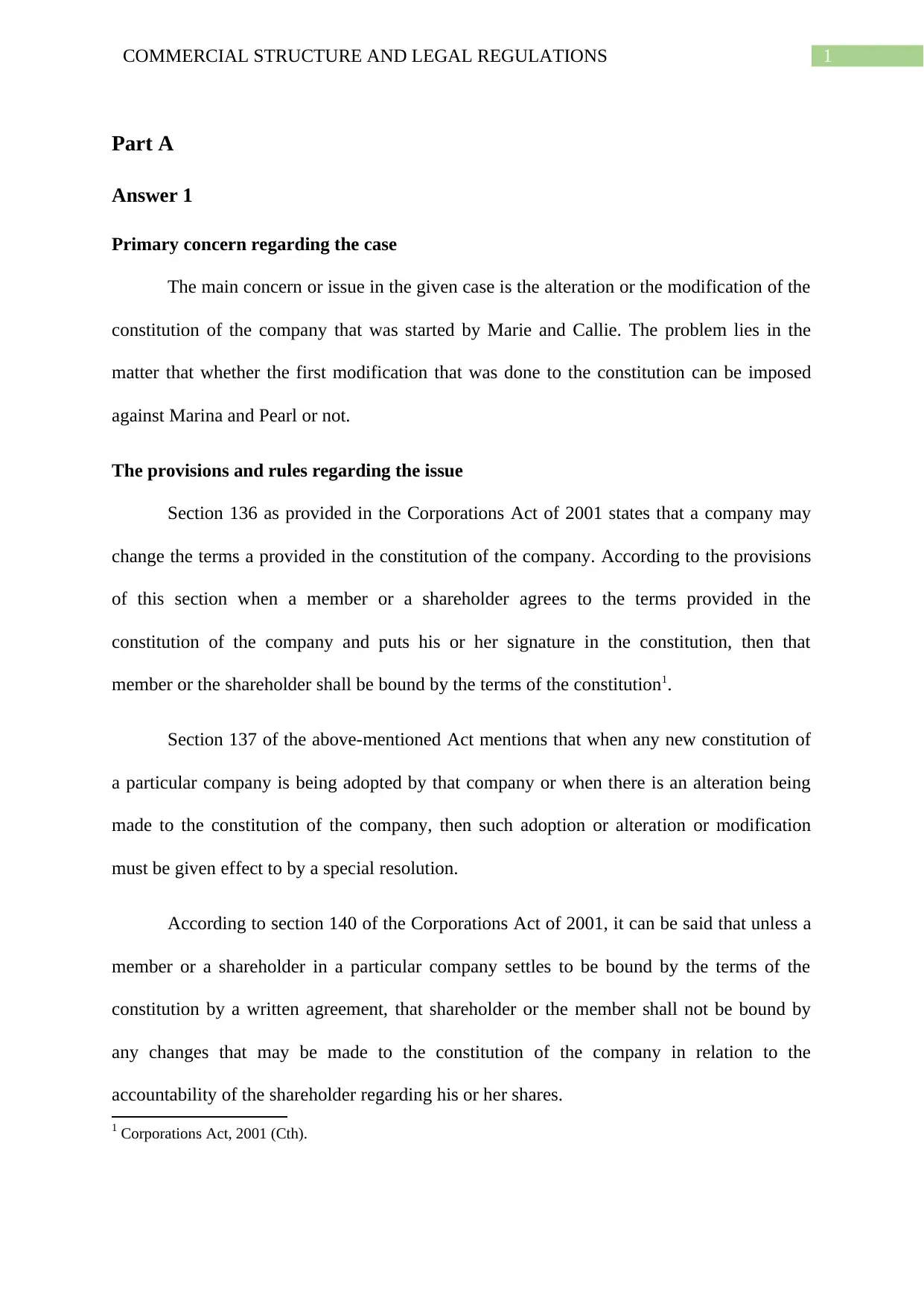
1COMMERCIAL STRUCTURE AND LEGAL REGULATIONS
Part A
Answer 1
Primary concern regarding the case
The main concern or issue in the given case is the alteration or the modification of the
constitution of the company that was started by Marie and Callie. The problem lies in the
matter that whether the first modification that was done to the constitution can be imposed
against Marina and Pearl or not.
The provisions and rules regarding the issue
Section 136 as provided in the Corporations Act of 2001 states that a company may
change the terms a provided in the constitution of the company. According to the provisions
of this section when a member or a shareholder agrees to the terms provided in the
constitution of the company and puts his or her signature in the constitution, then that
member or the shareholder shall be bound by the terms of the constitution1.
Section 137 of the above-mentioned Act mentions that when any new constitution of
a particular company is being adopted by that company or when there is an alteration being
made to the constitution of the company, then such adoption or alteration or modification
must be given effect to by a special resolution.
According to section 140 of the Corporations Act of 2001, it can be said that unless a
member or a shareholder in a particular company settles to be bound by the terms of the
constitution by a written agreement, that shareholder or the member shall not be bound by
any changes that may be made to the constitution of the company in relation to the
accountability of the shareholder regarding his or her shares.
1 Corporations Act, 2001 (Cth).
Part A
Answer 1
Primary concern regarding the case
The main concern or issue in the given case is the alteration or the modification of the
constitution of the company that was started by Marie and Callie. The problem lies in the
matter that whether the first modification that was done to the constitution can be imposed
against Marina and Pearl or not.
The provisions and rules regarding the issue
Section 136 as provided in the Corporations Act of 2001 states that a company may
change the terms a provided in the constitution of the company. According to the provisions
of this section when a member or a shareholder agrees to the terms provided in the
constitution of the company and puts his or her signature in the constitution, then that
member or the shareholder shall be bound by the terms of the constitution1.
Section 137 of the above-mentioned Act mentions that when any new constitution of
a particular company is being adopted by that company or when there is an alteration being
made to the constitution of the company, then such adoption or alteration or modification
must be given effect to by a special resolution.
According to section 140 of the Corporations Act of 2001, it can be said that unless a
member or a shareholder in a particular company settles to be bound by the terms of the
constitution by a written agreement, that shareholder or the member shall not be bound by
any changes that may be made to the constitution of the company in relation to the
accountability of the shareholder regarding his or her shares.
1 Corporations Act, 2001 (Cth).
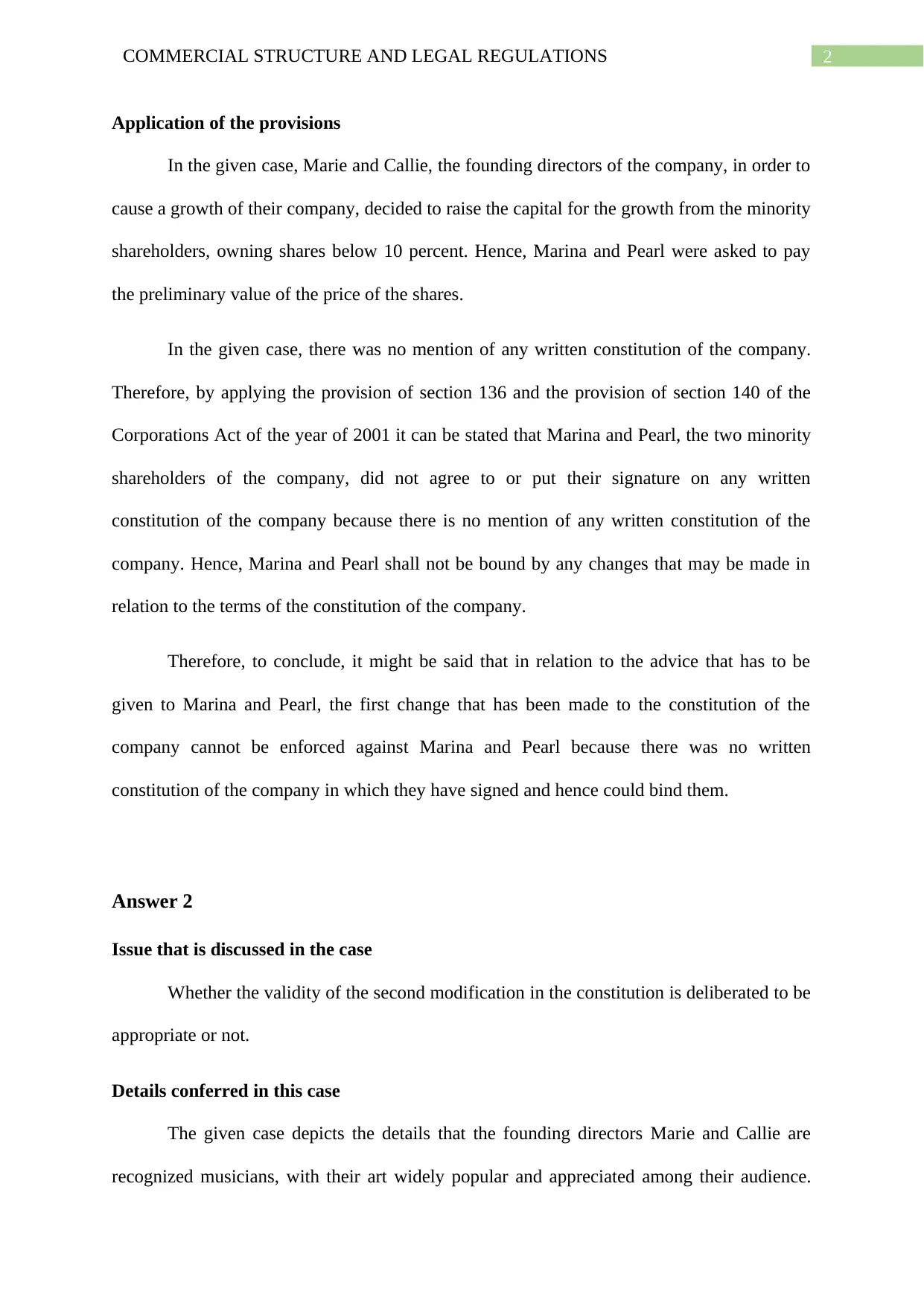
2COMMERCIAL STRUCTURE AND LEGAL REGULATIONS
Application of the provisions
In the given case, Marie and Callie, the founding directors of the company, in order to
cause a growth of their company, decided to raise the capital for the growth from the minority
shareholders, owning shares below 10 percent. Hence, Marina and Pearl were asked to pay
the preliminary value of the price of the shares.
In the given case, there was no mention of any written constitution of the company.
Therefore, by applying the provision of section 136 and the provision of section 140 of the
Corporations Act of the year of 2001 it can be stated that Marina and Pearl, the two minority
shareholders of the company, did not agree to or put their signature on any written
constitution of the company because there is no mention of any written constitution of the
company. Hence, Marina and Pearl shall not be bound by any changes that may be made in
relation to the terms of the constitution of the company.
Therefore, to conclude, it might be said that in relation to the advice that has to be
given to Marina and Pearl, the first change that has been made to the constitution of the
company cannot be enforced against Marina and Pearl because there was no written
constitution of the company in which they have signed and hence could bind them.
Answer 2
Issue that is discussed in the case
Whether the validity of the second modification in the constitution is deliberated to be
appropriate or not.
Details conferred in this case
The given case depicts the details that the founding directors Marie and Callie are
recognized musicians, with their art widely popular and appreciated among their audience.
Application of the provisions
In the given case, Marie and Callie, the founding directors of the company, in order to
cause a growth of their company, decided to raise the capital for the growth from the minority
shareholders, owning shares below 10 percent. Hence, Marina and Pearl were asked to pay
the preliminary value of the price of the shares.
In the given case, there was no mention of any written constitution of the company.
Therefore, by applying the provision of section 136 and the provision of section 140 of the
Corporations Act of the year of 2001 it can be stated that Marina and Pearl, the two minority
shareholders of the company, did not agree to or put their signature on any written
constitution of the company because there is no mention of any written constitution of the
company. Hence, Marina and Pearl shall not be bound by any changes that may be made in
relation to the terms of the constitution of the company.
Therefore, to conclude, it might be said that in relation to the advice that has to be
given to Marina and Pearl, the first change that has been made to the constitution of the
company cannot be enforced against Marina and Pearl because there was no written
constitution of the company in which they have signed and hence could bind them.
Answer 2
Issue that is discussed in the case
Whether the validity of the second modification in the constitution is deliberated to be
appropriate or not.
Details conferred in this case
The given case depicts the details that the founding directors Marie and Callie are
recognized musicians, with their art widely popular and appreciated among their audience.
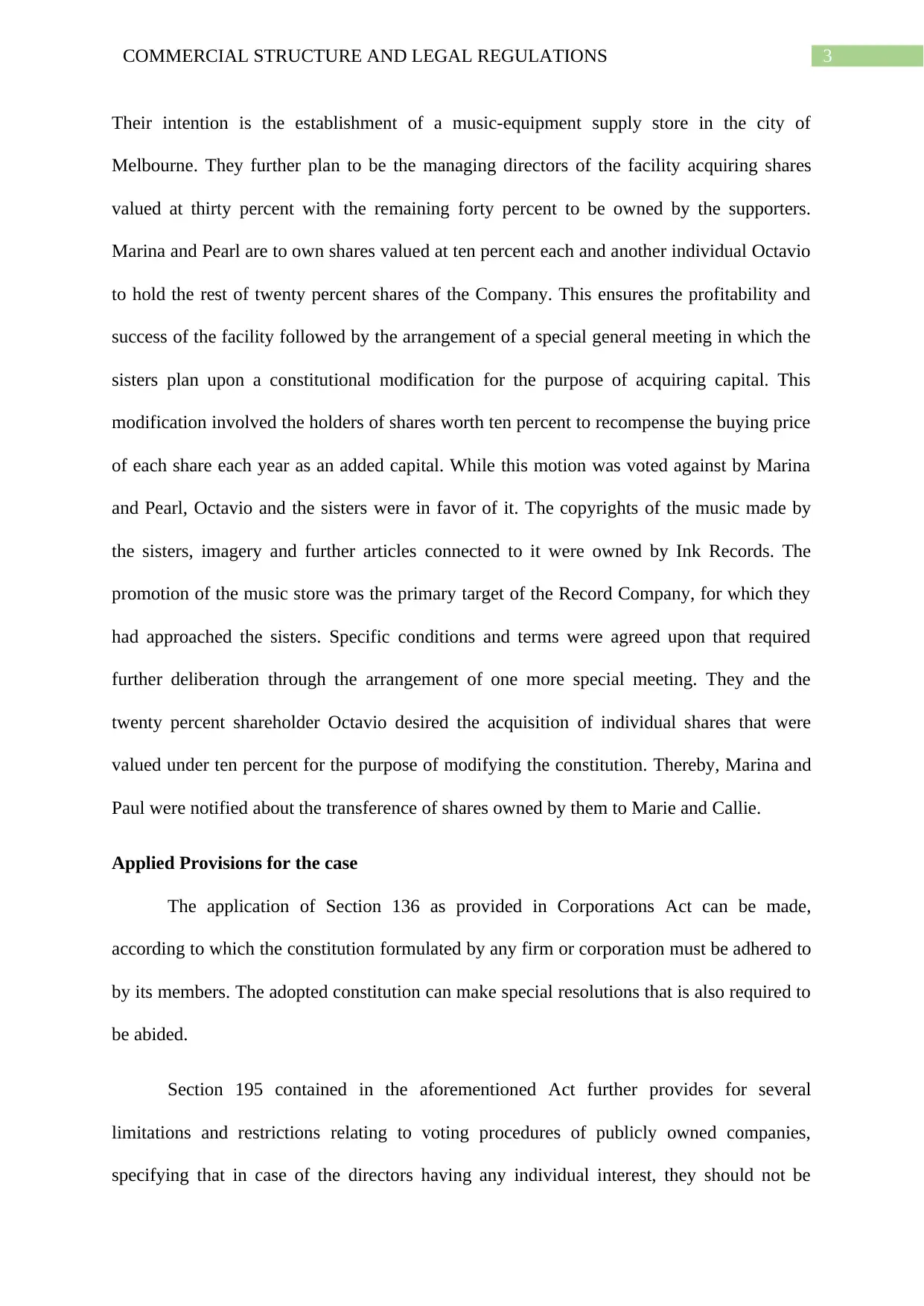
3COMMERCIAL STRUCTURE AND LEGAL REGULATIONS
Their intention is the establishment of a music-equipment supply store in the city of
Melbourne. They further plan to be the managing directors of the facility acquiring shares
valued at thirty percent with the remaining forty percent to be owned by the supporters.
Marina and Pearl are to own shares valued at ten percent each and another individual Octavio
to hold the rest of twenty percent shares of the Company. This ensures the profitability and
success of the facility followed by the arrangement of a special general meeting in which the
sisters plan upon a constitutional modification for the purpose of acquiring capital. This
modification involved the holders of shares worth ten percent to recompense the buying price
of each share each year as an added capital. While this motion was voted against by Marina
and Pearl, Octavio and the sisters were in favor of it. The copyrights of the music made by
the sisters, imagery and further articles connected to it were owned by Ink Records. The
promotion of the music store was the primary target of the Record Company, for which they
had approached the sisters. Specific conditions and terms were agreed upon that required
further deliberation through the arrangement of one more special meeting. They and the
twenty percent shareholder Octavio desired the acquisition of individual shares that were
valued under ten percent for the purpose of modifying the constitution. Thereby, Marina and
Paul were notified about the transference of shares owned by them to Marie and Callie.
Applied Provisions for the case
The application of Section 136 as provided in Corporations Act can be made,
according to which the constitution formulated by any firm or corporation must be adhered to
by its members. The adopted constitution can make special resolutions that is also required to
be abided.
Section 195 contained in the aforementioned Act further provides for several
limitations and restrictions relating to voting procedures of publicly owned companies,
specifying that in case of the directors having any individual interest, they should not be
Their intention is the establishment of a music-equipment supply store in the city of
Melbourne. They further plan to be the managing directors of the facility acquiring shares
valued at thirty percent with the remaining forty percent to be owned by the supporters.
Marina and Pearl are to own shares valued at ten percent each and another individual Octavio
to hold the rest of twenty percent shares of the Company. This ensures the profitability and
success of the facility followed by the arrangement of a special general meeting in which the
sisters plan upon a constitutional modification for the purpose of acquiring capital. This
modification involved the holders of shares worth ten percent to recompense the buying price
of each share each year as an added capital. While this motion was voted against by Marina
and Pearl, Octavio and the sisters were in favor of it. The copyrights of the music made by
the sisters, imagery and further articles connected to it were owned by Ink Records. The
promotion of the music store was the primary target of the Record Company, for which they
had approached the sisters. Specific conditions and terms were agreed upon that required
further deliberation through the arrangement of one more special meeting. They and the
twenty percent shareholder Octavio desired the acquisition of individual shares that were
valued under ten percent for the purpose of modifying the constitution. Thereby, Marina and
Paul were notified about the transference of shares owned by them to Marie and Callie.
Applied Provisions for the case
The application of Section 136 as provided in Corporations Act can be made,
according to which the constitution formulated by any firm or corporation must be adhered to
by its members. The adopted constitution can make special resolutions that is also required to
be abided.
Section 195 contained in the aforementioned Act further provides for several
limitations and restrictions relating to voting procedures of publicly owned companies,
specifying that in case of the directors having any individual interest, they should not be
Secure Best Marks with AI Grader
Need help grading? Try our AI Grader for instant feedback on your assignments.
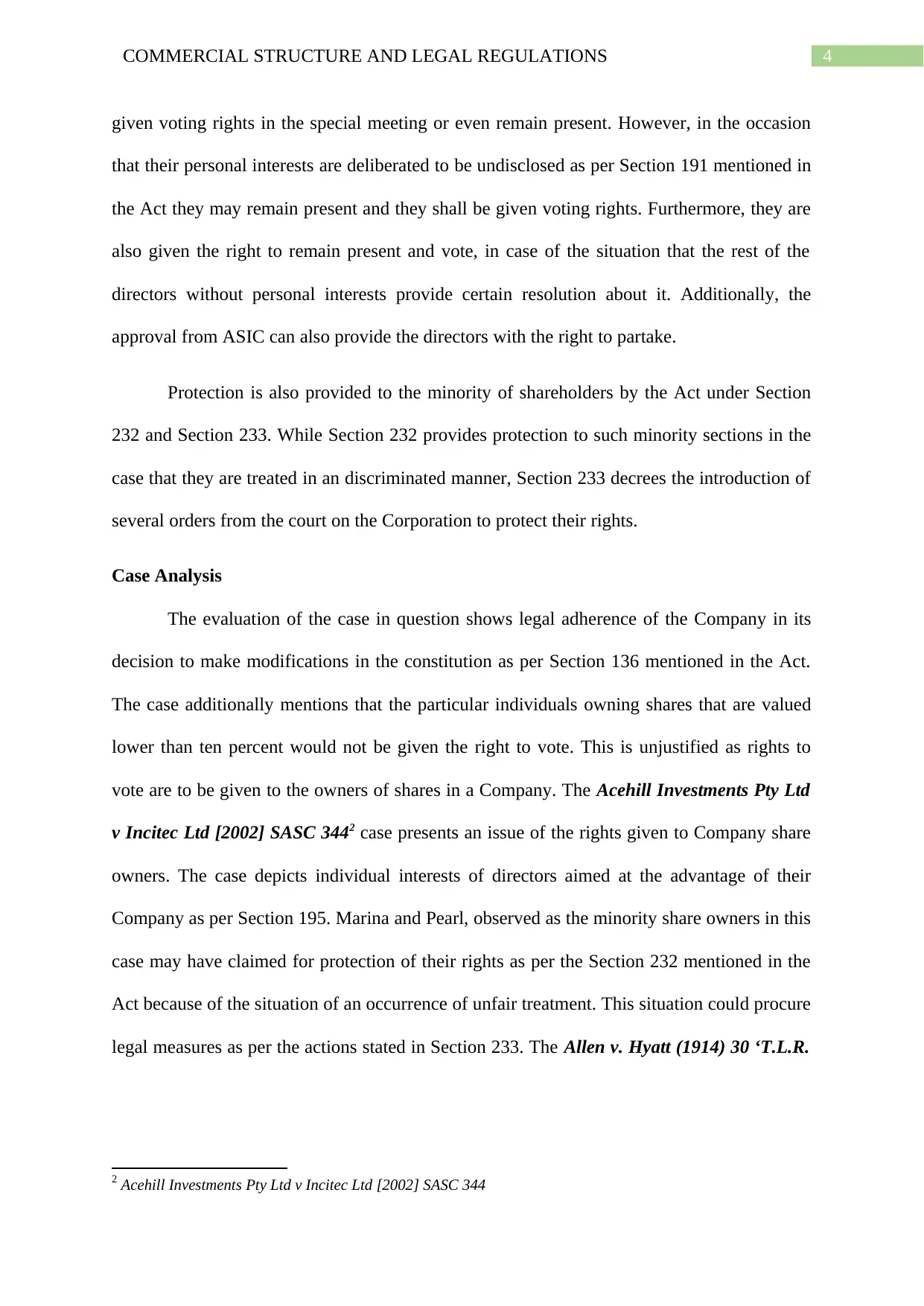
4COMMERCIAL STRUCTURE AND LEGAL REGULATIONS
given voting rights in the special meeting or even remain present. However, in the occasion
that their personal interests are deliberated to be undisclosed as per Section 191 mentioned in
the Act they may remain present and they shall be given voting rights. Furthermore, they are
also given the right to remain present and vote, in case of the situation that the rest of the
directors without personal interests provide certain resolution about it. Additionally, the
approval from ASIC can also provide the directors with the right to partake.
Protection is also provided to the minority of shareholders by the Act under Section
232 and Section 233. While Section 232 provides protection to such minority sections in the
case that they are treated in an discriminated manner, Section 233 decrees the introduction of
several orders from the court on the Corporation to protect their rights.
Case Analysis
The evaluation of the case in question shows legal adherence of the Company in its
decision to make modifications in the constitution as per Section 136 mentioned in the Act.
The case additionally mentions that the particular individuals owning shares that are valued
lower than ten percent would not be given the right to vote. This is unjustified as rights to
vote are to be given to the owners of shares in a Company. The Acehill Investments Pty Ltd
v Incitec Ltd [2002] SASC 3442 case presents an issue of the rights given to Company share
owners. The case depicts individual interests of directors aimed at the advantage of their
Company as per Section 195. Marina and Pearl, observed as the minority share owners in this
case may have claimed for protection of their rights as per the Section 232 mentioned in the
Act because of the situation of an occurrence of unfair treatment. This situation could procure
legal measures as per the actions stated in Section 233. The Allen v. Hyatt (1914) 30 ‘T.L.R.
2 Acehill Investments Pty Ltd v Incitec Ltd [2002] SASC 344
given voting rights in the special meeting or even remain present. However, in the occasion
that their personal interests are deliberated to be undisclosed as per Section 191 mentioned in
the Act they may remain present and they shall be given voting rights. Furthermore, they are
also given the right to remain present and vote, in case of the situation that the rest of the
directors without personal interests provide certain resolution about it. Additionally, the
approval from ASIC can also provide the directors with the right to partake.
Protection is also provided to the minority of shareholders by the Act under Section
232 and Section 233. While Section 232 provides protection to such minority sections in the
case that they are treated in an discriminated manner, Section 233 decrees the introduction of
several orders from the court on the Corporation to protect their rights.
Case Analysis
The evaluation of the case in question shows legal adherence of the Company in its
decision to make modifications in the constitution as per Section 136 mentioned in the Act.
The case additionally mentions that the particular individuals owning shares that are valued
lower than ten percent would not be given the right to vote. This is unjustified as rights to
vote are to be given to the owners of shares in a Company. The Acehill Investments Pty Ltd
v Incitec Ltd [2002] SASC 3442 case presents an issue of the rights given to Company share
owners. The case depicts individual interests of directors aimed at the advantage of their
Company as per Section 195. Marina and Pearl, observed as the minority share owners in this
case may have claimed for protection of their rights as per the Section 232 mentioned in the
Act because of the situation of an occurrence of unfair treatment. This situation could procure
legal measures as per the actions stated in Section 233. The Allen v. Hyatt (1914) 30 ‘T.L.R.
2 Acehill Investments Pty Ltd v Incitec Ltd [2002] SASC 344
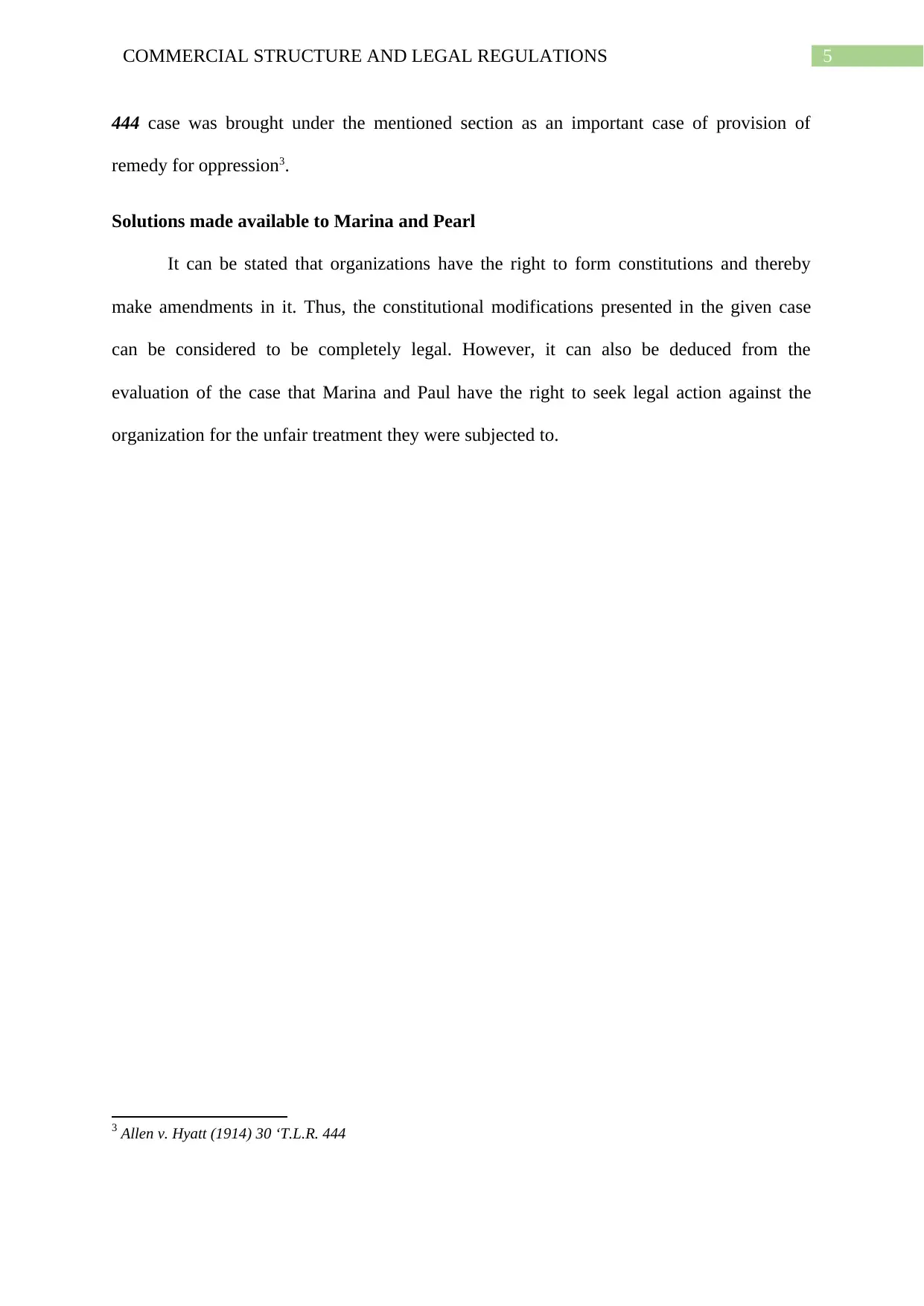
5COMMERCIAL STRUCTURE AND LEGAL REGULATIONS
444 case was brought under the mentioned section as an important case of provision of
remedy for oppression3.
Solutions made available to Marina and Pearl
It can be stated that organizations have the right to form constitutions and thereby
make amendments in it. Thus, the constitutional modifications presented in the given case
can be considered to be completely legal. However, it can also be deduced from the
evaluation of the case that Marina and Paul have the right to seek legal action against the
organization for the unfair treatment they were subjected to.
3 Allen v. Hyatt (1914) 30 ‘T.L.R. 444
444 case was brought under the mentioned section as an important case of provision of
remedy for oppression3.
Solutions made available to Marina and Pearl
It can be stated that organizations have the right to form constitutions and thereby
make amendments in it. Thus, the constitutional modifications presented in the given case
can be considered to be completely legal. However, it can also be deduced from the
evaluation of the case that Marina and Paul have the right to seek legal action against the
organization for the unfair treatment they were subjected to.
3 Allen v. Hyatt (1914) 30 ‘T.L.R. 444
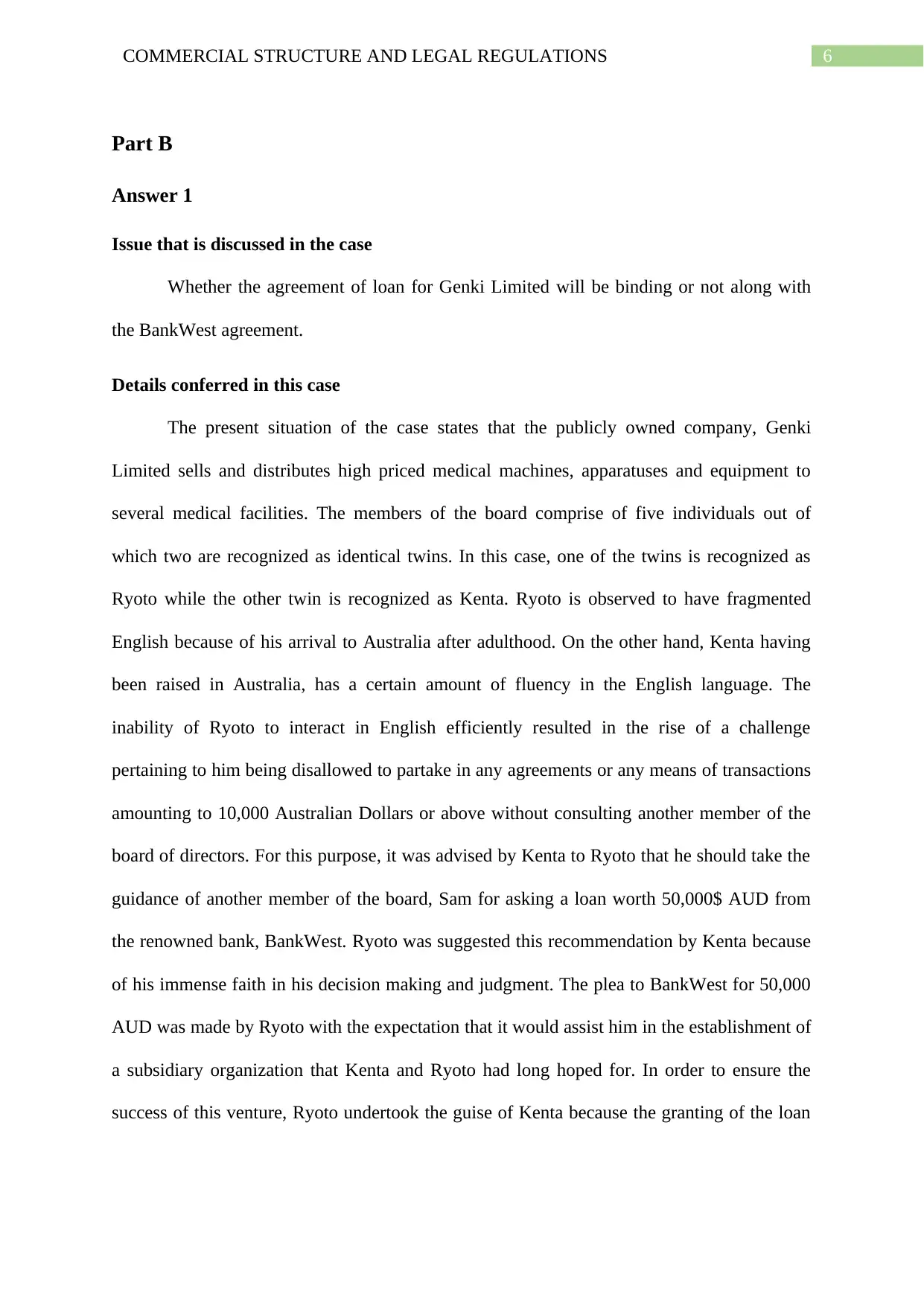
6COMMERCIAL STRUCTURE AND LEGAL REGULATIONS
Part B
Answer 1
Issue that is discussed in the case
Whether the agreement of loan for Genki Limited will be binding or not along with
the BankWest agreement.
Details conferred in this case
The present situation of the case states that the publicly owned company, Genki
Limited sells and distributes high priced medical machines, apparatuses and equipment to
several medical facilities. The members of the board comprise of five individuals out of
which two are recognized as identical twins. In this case, one of the twins is recognized as
Ryoto while the other twin is recognized as Kenta. Ryoto is observed to have fragmented
English because of his arrival to Australia after adulthood. On the other hand, Kenta having
been raised in Australia, has a certain amount of fluency in the English language. The
inability of Ryoto to interact in English efficiently resulted in the rise of a challenge
pertaining to him being disallowed to partake in any agreements or any means of transactions
amounting to 10,000 Australian Dollars or above without consulting another member of the
board of directors. For this purpose, it was advised by Kenta to Ryoto that he should take the
guidance of another member of the board, Sam for asking a loan worth 50,000$ AUD from
the renowned bank, BankWest. Ryoto was suggested this recommendation by Kenta because
of his immense faith in his decision making and judgment. The plea to BankWest for 50,000
AUD was made by Ryoto with the expectation that it would assist him in the establishment of
a subsidiary organization that Kenta and Ryoto had long hoped for. In order to ensure the
success of this venture, Ryoto undertook the guise of Kenta because the granting of the loan
Part B
Answer 1
Issue that is discussed in the case
Whether the agreement of loan for Genki Limited will be binding or not along with
the BankWest agreement.
Details conferred in this case
The present situation of the case states that the publicly owned company, Genki
Limited sells and distributes high priced medical machines, apparatuses and equipment to
several medical facilities. The members of the board comprise of five individuals out of
which two are recognized as identical twins. In this case, one of the twins is recognized as
Ryoto while the other twin is recognized as Kenta. Ryoto is observed to have fragmented
English because of his arrival to Australia after adulthood. On the other hand, Kenta having
been raised in Australia, has a certain amount of fluency in the English language. The
inability of Ryoto to interact in English efficiently resulted in the rise of a challenge
pertaining to him being disallowed to partake in any agreements or any means of transactions
amounting to 10,000 Australian Dollars or above without consulting another member of the
board of directors. For this purpose, it was advised by Kenta to Ryoto that he should take the
guidance of another member of the board, Sam for asking a loan worth 50,000$ AUD from
the renowned bank, BankWest. Ryoto was suggested this recommendation by Kenta because
of his immense faith in his decision making and judgment. The plea to BankWest for 50,000
AUD was made by Ryoto with the expectation that it would assist him in the establishment of
a subsidiary organization that Kenta and Ryoto had long hoped for. In order to ensure the
success of this venture, Ryoto undertook the guise of Kenta because the granting of the loan
Paraphrase This Document
Need a fresh take? Get an instant paraphrase of this document with our AI Paraphraser
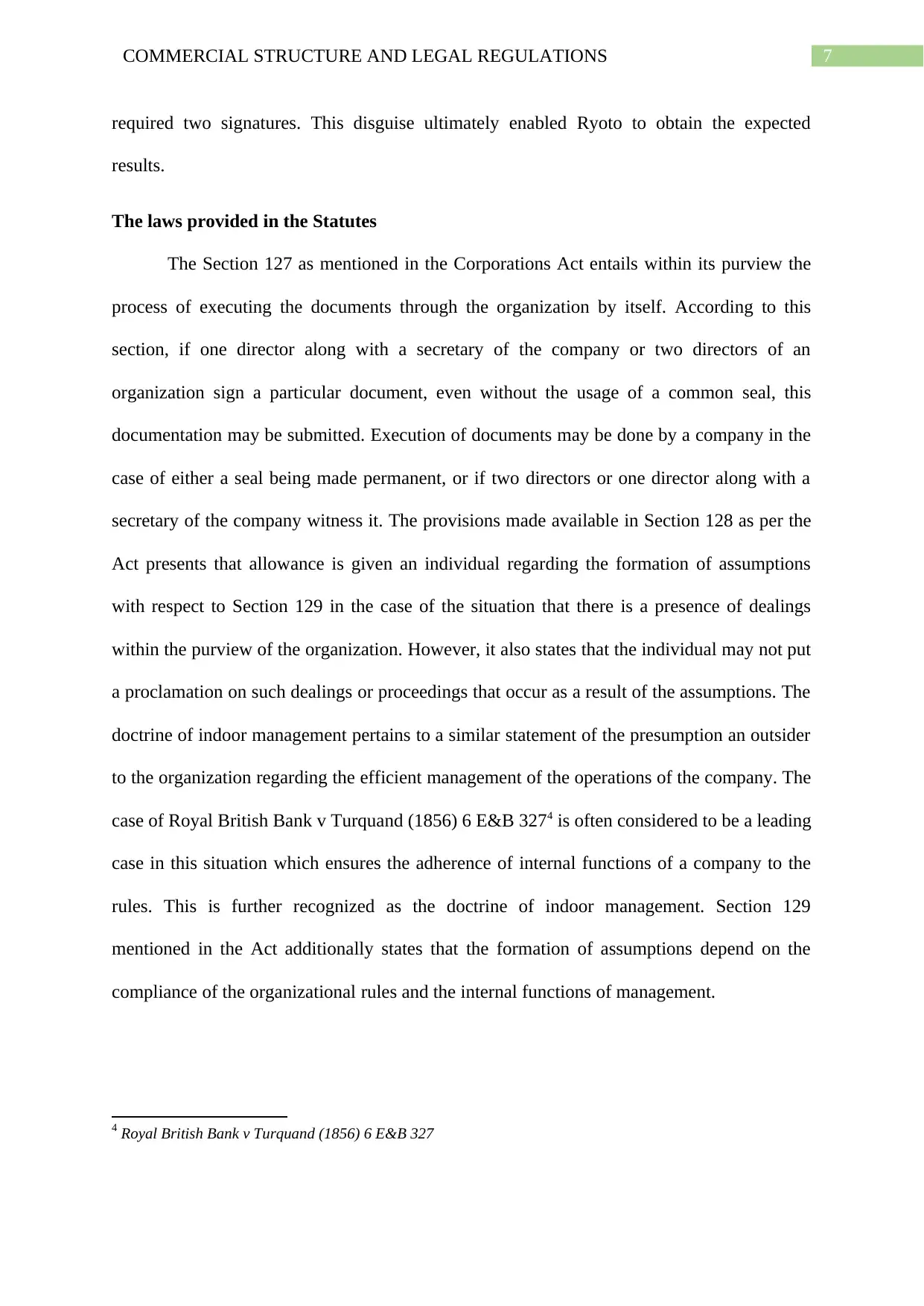
7COMMERCIAL STRUCTURE AND LEGAL REGULATIONS
required two signatures. This disguise ultimately enabled Ryoto to obtain the expected
results.
The laws provided in the Statutes
The Section 127 as mentioned in the Corporations Act entails within its purview the
process of executing the documents through the organization by itself. According to this
section, if one director along with a secretary of the company or two directors of an
organization sign a particular document, even without the usage of a common seal, this
documentation may be submitted. Execution of documents may be done by a company in the
case of either a seal being made permanent, or if two directors or one director along with a
secretary of the company witness it. The provisions made available in Section 128 as per the
Act presents that allowance is given an individual regarding the formation of assumptions
with respect to Section 129 in the case of the situation that there is a presence of dealings
within the purview of the organization. However, it also states that the individual may not put
a proclamation on such dealings or proceedings that occur as a result of the assumptions. The
doctrine of indoor management pertains to a similar statement of the presumption an outsider
to the organization regarding the efficient management of the operations of the company. The
case of Royal British Bank v Turquand (1856) 6 E&B 3274 is often considered to be a leading
case in this situation which ensures the adherence of internal functions of a company to the
rules. This is further recognized as the doctrine of indoor management. Section 129
mentioned in the Act additionally states that the formation of assumptions depend on the
compliance of the organizational rules and the internal functions of management.
4 Royal British Bank v Turquand (1856) 6 E&B 327
required two signatures. This disguise ultimately enabled Ryoto to obtain the expected
results.
The laws provided in the Statutes
The Section 127 as mentioned in the Corporations Act entails within its purview the
process of executing the documents through the organization by itself. According to this
section, if one director along with a secretary of the company or two directors of an
organization sign a particular document, even without the usage of a common seal, this
documentation may be submitted. Execution of documents may be done by a company in the
case of either a seal being made permanent, or if two directors or one director along with a
secretary of the company witness it. The provisions made available in Section 128 as per the
Act presents that allowance is given an individual regarding the formation of assumptions
with respect to Section 129 in the case of the situation that there is a presence of dealings
within the purview of the organization. However, it also states that the individual may not put
a proclamation on such dealings or proceedings that occur as a result of the assumptions. The
doctrine of indoor management pertains to a similar statement of the presumption an outsider
to the organization regarding the efficient management of the operations of the company. The
case of Royal British Bank v Turquand (1856) 6 E&B 3274 is often considered to be a leading
case in this situation which ensures the adherence of internal functions of a company to the
rules. This is further recognized as the doctrine of indoor management. Section 129
mentioned in the Act additionally states that the formation of assumptions depend on the
compliance of the organizational rules and the internal functions of management.
4 Royal British Bank v Turquand (1856) 6 E&B 327
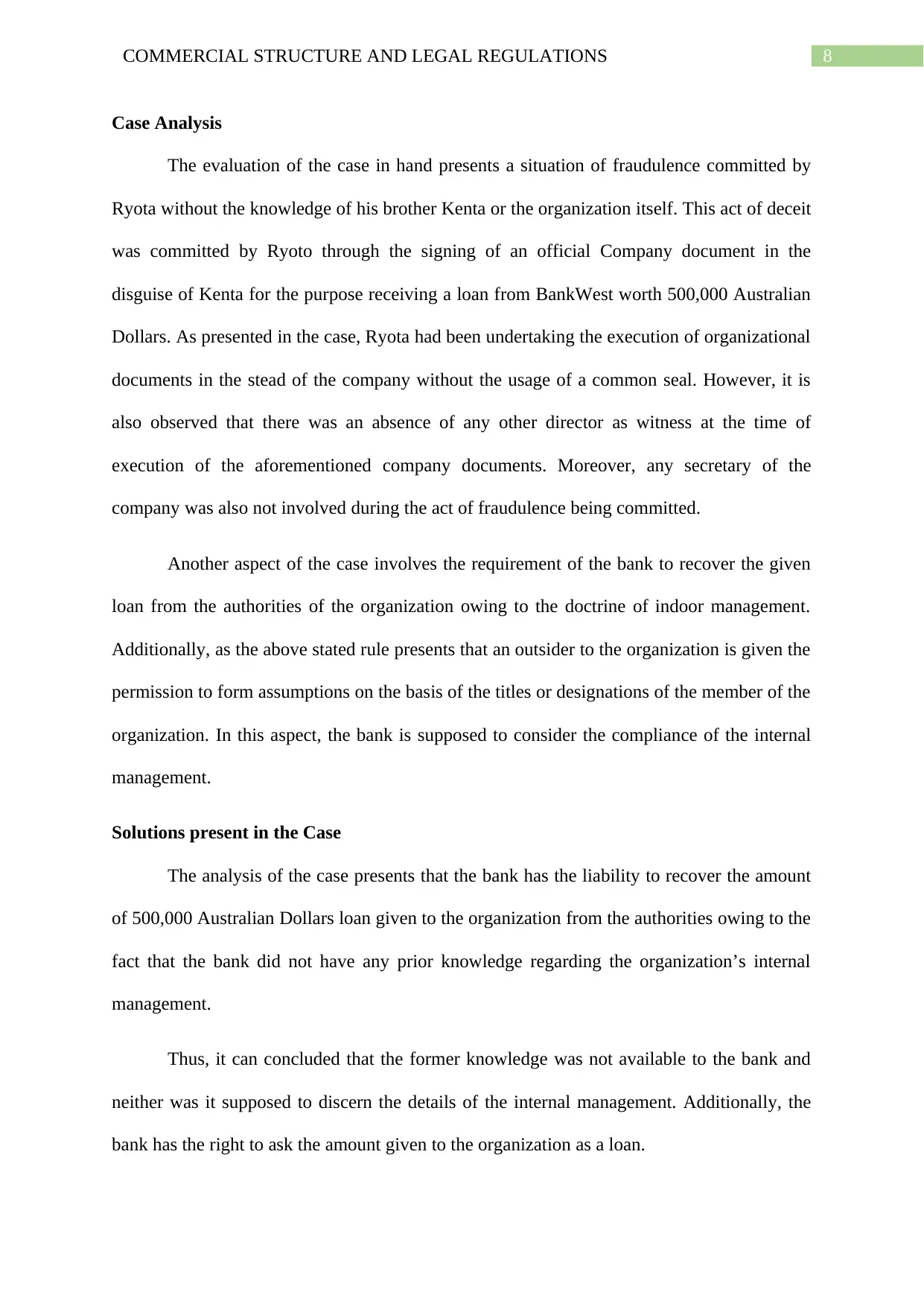
8COMMERCIAL STRUCTURE AND LEGAL REGULATIONS
Case Analysis
The evaluation of the case in hand presents a situation of fraudulence committed by
Ryota without the knowledge of his brother Kenta or the organization itself. This act of deceit
was committed by Ryoto through the signing of an official Company document in the
disguise of Kenta for the purpose receiving a loan from BankWest worth 500,000 Australian
Dollars. As presented in the case, Ryota had been undertaking the execution of organizational
documents in the stead of the company without the usage of a common seal. However, it is
also observed that there was an absence of any other director as witness at the time of
execution of the aforementioned company documents. Moreover, any secretary of the
company was also not involved during the act of fraudulence being committed.
Another aspect of the case involves the requirement of the bank to recover the given
loan from the authorities of the organization owing to the doctrine of indoor management.
Additionally, as the above stated rule presents that an outsider to the organization is given the
permission to form assumptions on the basis of the titles or designations of the member of the
organization. In this aspect, the bank is supposed to consider the compliance of the internal
management.
Solutions present in the Case
The analysis of the case presents that the bank has the liability to recover the amount
of 500,000 Australian Dollars loan given to the organization from the authorities owing to the
fact that the bank did not have any prior knowledge regarding the organization’s internal
management.
Thus, it can concluded that the former knowledge was not available to the bank and
neither was it supposed to discern the details of the internal management. Additionally, the
bank has the right to ask the amount given to the organization as a loan.
Case Analysis
The evaluation of the case in hand presents a situation of fraudulence committed by
Ryota without the knowledge of his brother Kenta or the organization itself. This act of deceit
was committed by Ryoto through the signing of an official Company document in the
disguise of Kenta for the purpose receiving a loan from BankWest worth 500,000 Australian
Dollars. As presented in the case, Ryota had been undertaking the execution of organizational
documents in the stead of the company without the usage of a common seal. However, it is
also observed that there was an absence of any other director as witness at the time of
execution of the aforementioned company documents. Moreover, any secretary of the
company was also not involved during the act of fraudulence being committed.
Another aspect of the case involves the requirement of the bank to recover the given
loan from the authorities of the organization owing to the doctrine of indoor management.
Additionally, as the above stated rule presents that an outsider to the organization is given the
permission to form assumptions on the basis of the titles or designations of the member of the
organization. In this aspect, the bank is supposed to consider the compliance of the internal
management.
Solutions present in the Case
The analysis of the case presents that the bank has the liability to recover the amount
of 500,000 Australian Dollars loan given to the organization from the authorities owing to the
fact that the bank did not have any prior knowledge regarding the organization’s internal
management.
Thus, it can concluded that the former knowledge was not available to the bank and
neither was it supposed to discern the details of the internal management. Additionally, the
bank has the right to ask the amount given to the organization as a loan.
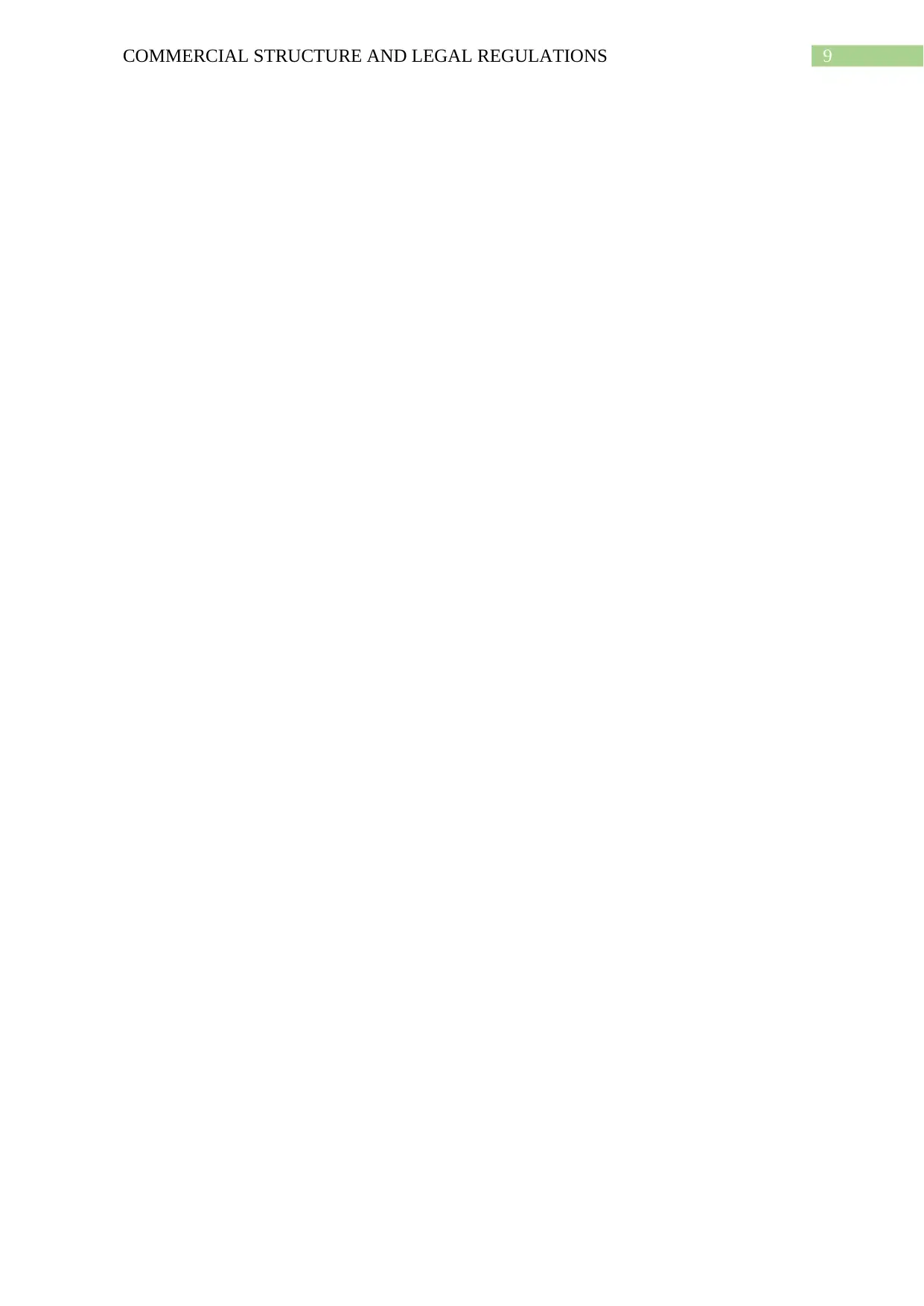
9COMMERCIAL STRUCTURE AND LEGAL REGULATIONS
Secure Best Marks with AI Grader
Need help grading? Try our AI Grader for instant feedback on your assignments.
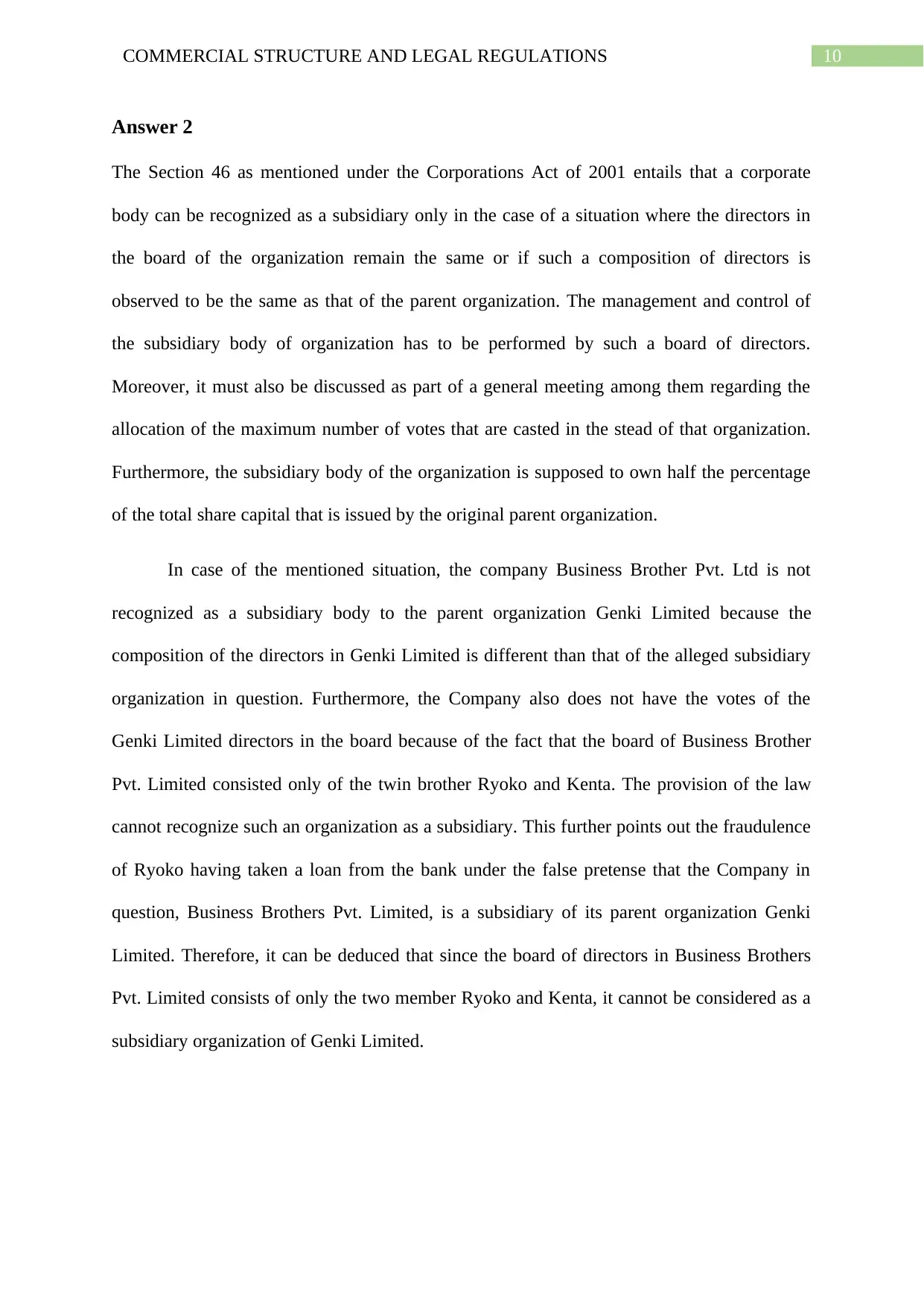
10COMMERCIAL STRUCTURE AND LEGAL REGULATIONS
Answer 2
The Section 46 as mentioned under the Corporations Act of 2001 entails that a corporate
body can be recognized as a subsidiary only in the case of a situation where the directors in
the board of the organization remain the same or if such a composition of directors is
observed to be the same as that of the parent organization. The management and control of
the subsidiary body of organization has to be performed by such a board of directors.
Moreover, it must also be discussed as part of a general meeting among them regarding the
allocation of the maximum number of votes that are casted in the stead of that organization.
Furthermore, the subsidiary body of the organization is supposed to own half the percentage
of the total share capital that is issued by the original parent organization.
In case of the mentioned situation, the company Business Brother Pvt. Ltd is not
recognized as a subsidiary body to the parent organization Genki Limited because the
composition of the directors in Genki Limited is different than that of the alleged subsidiary
organization in question. Furthermore, the Company also does not have the votes of the
Genki Limited directors in the board because of the fact that the board of Business Brother
Pvt. Limited consisted only of the twin brother Ryoko and Kenta. The provision of the law
cannot recognize such an organization as a subsidiary. This further points out the fraudulence
of Ryoko having taken a loan from the bank under the false pretense that the Company in
question, Business Brothers Pvt. Limited, is a subsidiary of its parent organization Genki
Limited. Therefore, it can be deduced that since the board of directors in Business Brothers
Pvt. Limited consists of only the two member Ryoko and Kenta, it cannot be considered as a
subsidiary organization of Genki Limited.
Answer 2
The Section 46 as mentioned under the Corporations Act of 2001 entails that a corporate
body can be recognized as a subsidiary only in the case of a situation where the directors in
the board of the organization remain the same or if such a composition of directors is
observed to be the same as that of the parent organization. The management and control of
the subsidiary body of organization has to be performed by such a board of directors.
Moreover, it must also be discussed as part of a general meeting among them regarding the
allocation of the maximum number of votes that are casted in the stead of that organization.
Furthermore, the subsidiary body of the organization is supposed to own half the percentage
of the total share capital that is issued by the original parent organization.
In case of the mentioned situation, the company Business Brother Pvt. Ltd is not
recognized as a subsidiary body to the parent organization Genki Limited because the
composition of the directors in Genki Limited is different than that of the alleged subsidiary
organization in question. Furthermore, the Company also does not have the votes of the
Genki Limited directors in the board because of the fact that the board of Business Brother
Pvt. Limited consisted only of the twin brother Ryoko and Kenta. The provision of the law
cannot recognize such an organization as a subsidiary. This further points out the fraudulence
of Ryoko having taken a loan from the bank under the false pretense that the Company in
question, Business Brothers Pvt. Limited, is a subsidiary of its parent organization Genki
Limited. Therefore, it can be deduced that since the board of directors in Business Brothers
Pvt. Limited consists of only the two member Ryoko and Kenta, it cannot be considered as a
subsidiary organization of Genki Limited.
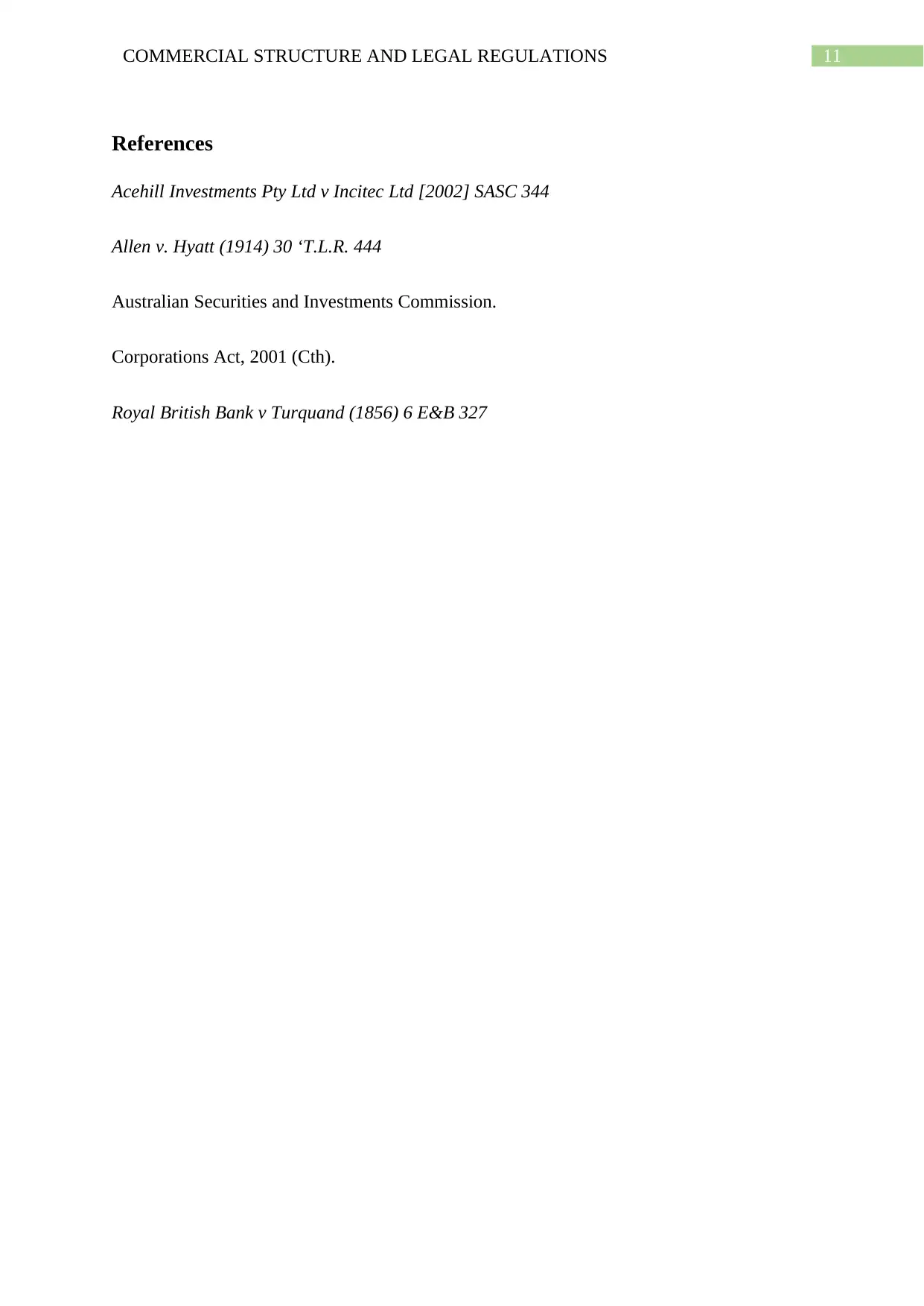
11COMMERCIAL STRUCTURE AND LEGAL REGULATIONS
References
Acehill Investments Pty Ltd v Incitec Ltd [2002] SASC 344
Allen v. Hyatt (1914) 30 ‘T.L.R. 444
Australian Securities and Investments Commission.
Corporations Act, 2001 (Cth).
Royal British Bank v Turquand (1856) 6 E&B 327
References
Acehill Investments Pty Ltd v Incitec Ltd [2002] SASC 344
Allen v. Hyatt (1914) 30 ‘T.L.R. 444
Australian Securities and Investments Commission.
Corporations Act, 2001 (Cth).
Royal British Bank v Turquand (1856) 6 E&B 327
1 out of 12
Related Documents
Your All-in-One AI-Powered Toolkit for Academic Success.
+13062052269
info@desklib.com
Available 24*7 on WhatsApp / Email
![[object Object]](/_next/static/media/star-bottom.7253800d.svg)
Unlock your academic potential
© 2024 | Zucol Services PVT LTD | All rights reserved.





